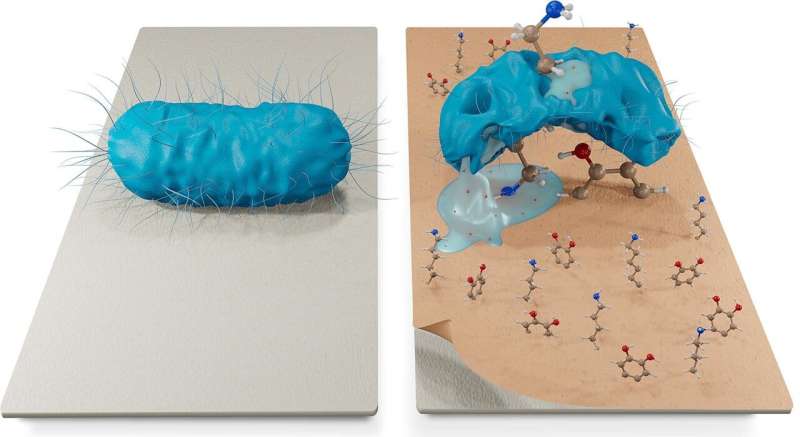Representation of the irreversible damage to the microorganism caused by coating the surface on the right with the new material developed by the UAB and ICN2 researchers. Credit: Chemical Engineering Journal (2024). DOI: 10.1016/j.cej.2024.148674
Researchers from the UAB and the ICN2 have developed an innovative material to fight against the spread of pathogens, infections and antimicrobial resistance. Inspired by the substances secreted by mussels to adhere to rocks, it can be used as a coating to protect health care fabrics and provides an effective alternative to commonly used materials such as paper, cotton, surgical masks and commercial plasters.
The research is published in the Chemical Engineering Journal.
The overuse of antibiotics has led to the development of antimicrobial resistance (AMR), a growing threat to public health worldwide. AMR occurs when bacteria change over time and no longer respond to drugs, antibiotics and other related antimicrobial medicines, making infections harder to treat and increasing the risk of pathogen spread, severe illness and death.
In fact, the World Health Organization (WHO) and United Nations (UN) have reported that AMR poses a major threat to human health around the world, probably overtaking cancer as the world's leading cause of death by 2050.
In this scenario, the development of novel and more efficient antibacterial materials has become essential to reduce pathogen spread, thus preventing infections. Of relevance is the control of bacterial populations in health environments such as hospitals and other health care units to avoid the so-called nosocomial infections, mainly due to bacterial colonization on biomedical surfaces.
Today, this type of infection is the sixth leading cause of death in industrialized countries, and much higher in the developing world, specially affecting immunocompromised and intensive care patients (e.g., burns) and those with chronic pathologies such as diabetes.
Among the different materials that may spread bacterial populations, fabrics represent an integral part of patient care: From the clothes of doctors, surgeons and nurses to medical curtains, bed sheets, pillow coverings, masks, gloves, and bandages, which are directly in contact with sutures and wounds. For all these reasons, antibacterial coatings for medical fabrics have become a very active field of research.
Researchers from the UAB Department of Biochemistry and Molecular Biology, the UAB Institute for Neuroscience (INc-UAB), and the Catalan Institute for Nanoscience and Nanotechnology (ICN2) have developed a family of biocompatible and bioinspired coatings produced by the co-polymerization between catechol derivatives and amino-terminal ligands.
Based on this, they have demonstrated that the use of these mussel-inspired coatings as efficient antimicrobial materials, based on their ability to evolve chemically over time in the presence of air and humid atmospheres, favoring the continuous formation of Reactive Oxygen Species (ROS). In fact, in addition to the formation of ROS, the synthetic methodology results in an excess of superficial free amino groups that induce the disruption of pathogen membranes.
"One of the main components found in the coatings (catechol and polyphenol derivatives) is found in the strands secreted by mussels, which are responsible for their adhesion to rocks under extreme conditions, under saline water," explain UAB professor Victor Yuste and ICN2 researcher Salvio Suárez. "The fact that the coatings we have developed are inspired by this organism allows them to adhere to practically any type of surface and, in addition, are highly resistant to different environmental conditions such as humidity or the presence of fluids.
More information: Jose Bolaños-Cardet et al, Bioinspired phenol-based coatings for medical fabrics against antimicrobial resistance, Chemical Engineering Journal (2024). DOI: 10.1016/j.cej.2024.148674
Provided by Autonomous University of Barcelona























